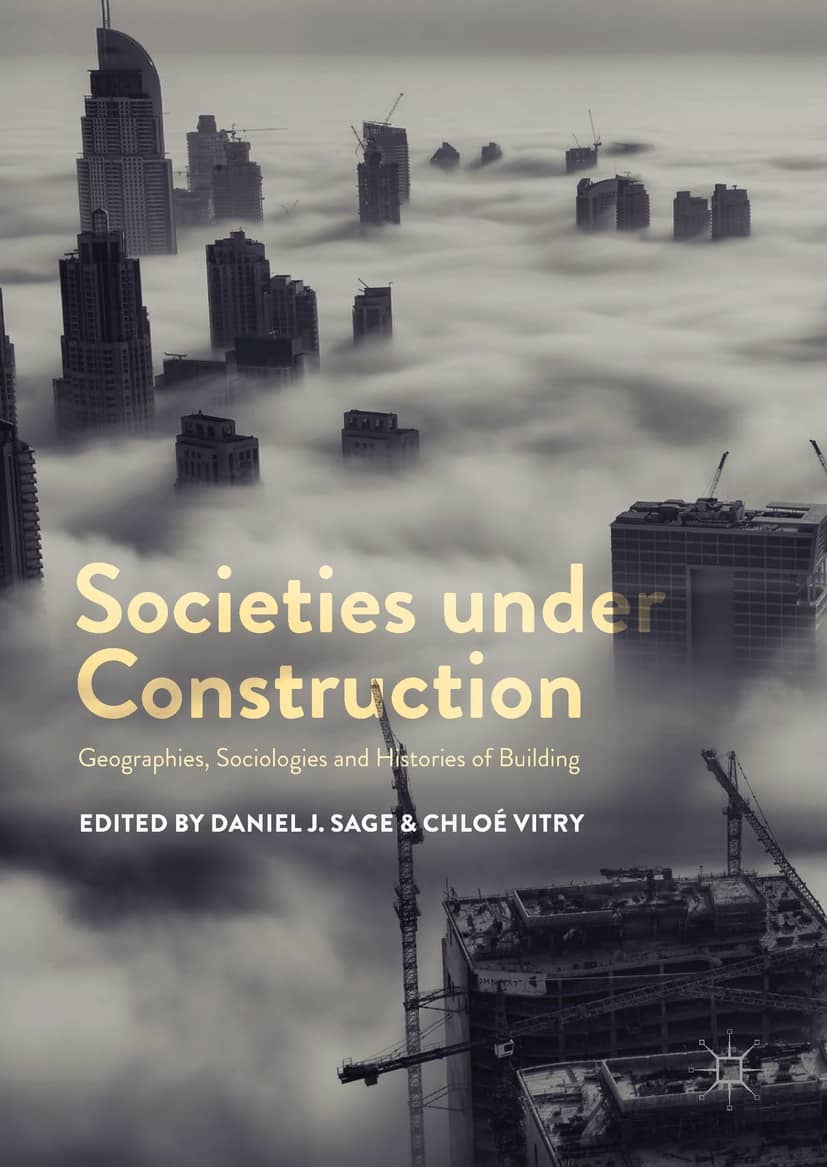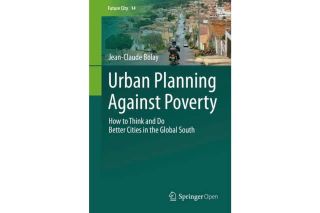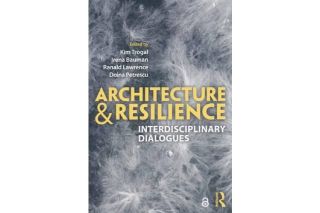
www.buildingsandcities.org/insights/reviews/societies-under-construction-review.html
Societies Under Construction: Geographies, Sociologies and Histories of Building
Edited by Daniel Sage and Chloé Vitry. Palgrave Macmillan, 2018, ISBN: 9783319739960.
Faye Wade (University of Edinburgh) reviews this book which explores how social science theories can be developed through studies of construction.This book addresses a disciplinary disconnect in studies of building construction, which:
"remains a comparably seldom visited object of analysis for academics based within social science and humanities departments…Equally, social science and humanities studies that do theorise with building construction often remain overlooked within the fields of construction engineering and management" (p.4)
Sage and Vitry set out to cross-fertilise the work of construction management and engineering scholars with social science and humanities scholars. Their intent is to provide scholars with new concepts, methodologies and empirical directions to understand construction. The book includes insights from three disciplines: sociology, human geography and history but other social science disciplines e.g. anthropology, philosophy and psychology are missing. Nonetheless, the approaches included usefully showcase the results when construction is relocated 'as a richer object of knowledge for human societies' (p.6). Specifically, the book seeks to encourage the development of theory through studies of construction (rather than straightforward application).
The Introduction's historical account provides useful framing for how labour and craftwork has been distinguished from, and identified as inferior to, the work of building design and engineering. This has significant implications for the prioritisation of 'design' work over construction work (in both professional training and research), and the interactions between both. Construction has typically been conceived as serving technical, managerial, physical and financial ends, rather than social ones. The book's subsequent chapters challenge these conceptualisations. The diverse chapters each provide theoretical ideas to develop through wide ranging studies of construction. Four key themes emerging on my reading of the book are: the inclusion of construction workers; buildings as 'always in the making'; instability; power and marketization.
The first theme of the inclusion of construction workers is particularly apparent in Paskins' (Chapter 3) history of 1960s urban transformation in Paris. Drawing on archival material, Paskins explores the role of construction work in debates around national identity, labour immigration and workers' rights. Paradoxically, construction workers themselves were often overlooked in public discourse around the transformation. Such historical understandings are needed to inform current debates. To tackle concerns about poor work safety records and improve literacy standards, French language lessons were provided to foreign workers on large building sites. Contemporary debates about multi-national construction teams, limited language ability and subsequent health and safety on construction sites remain a present concern. This begs the question why teaching languages has not become a norm in construction in the past 70 years.
Similarly moving from an organisational level to consideration of the individual, Sandberg, Räisänen, Löwstedt and Raiden (Chapter 4) use interviewing, observation and storytelling to explore how a female site manager conducts her everyday work. The authors do not set out to study gender per se, but through a focus on the participant's performance of work, they identify that the fast-moving nature of construction site work, combined with class-bound identities contribute as much to the bodily work of construction as prevalent ideas of gender. This is the only chapter that considers gender; this book could have contained more on how social theory can support, and be developed through, studies of gender and diversity in construction. However, with regard to inclusivity Chan (Chapter 5) also highlights that existing work in construction management has focused on professional elites, with a neglect of accounts of the work done on sites themselves. Chan identifies three new lines of inquiry to develop institutional theory using the construction industry as a setting: processes of change; more inclusive scholarship and practice; demise.
This final line of inquiry fits within the
second theme: buildings are always in the making. Indeed, as people
and organisations occupy buildings, they have a key role in 'making' the
building through operation and subtle transformations (Green & Seegova,
2020). As buildings often outlive their original purpose, Chan (Chapter 5) explores
how theories of institutional change can be used to study the re-purposing of
buildings. Patel and Tutt (Chapter 2) develop theoretical understandings of
enactment, specifically seeking to understand the 'generative consumption' of a
building through ethnography and historiography of a university library.
Significantly, they note that very few academic studies or performance
monitoring includes revisiting buildings
beyond five years of their construction. They conclude that research frameworks
need to look beyond notions of fixity, towards acknowledging the flexibility
and heterogeneous nature of buildings over time.
Continuing this theme, Grubbauer (Chapter 6)
focuses on informal settlements which are 'under permanent construction' in
Mexico City. There is a reliance on informal networks amongst these
'self-builders' for materials and skills. Although informal settlements
typically rely on informal networks of 'self-builders', this chapter studies
architects from a non-profit enterprise helping residents to remodel their
homes. In addition, this is the only contribution that is not set in a UK or EU
country. Further scholarship is needed to explore how the social theories
identified in this collection play out in construction projects and buildings
in more informal settlements, and densely populated cities in Asia, Africa, the
Middle East, Central and South America.
As Patel and Tutt note, studies of how
buildings are adapted throughout their lifetimes can provide new knowledge for designing for adaptability. The value of
the approaches outlined in this book for developing these understandings is
particularly apparent at the current time, whilst people are struggling to
adapt their homes and workplaces to manage the threat of coronavirus, climate
change, etc.
Chan (Chapter 5) also advocates for the use
of institutionalism to question the 'seemingly stable conceptualisation of the
construction industry' (p.152), linking to the third recurring theme: instability. In particular, institutional
norms can be crucial in shaping change, and resistance to it, within
construction. Chan's approach is valuable for future studies seeking to understand
efforts to encourage the development of more sustainable buildings, and
increase productivity in construction through the introduction of digital
technologies.
Often overlooked in explorations of
instability is wildlife. Sage, Justesen,
Dainty, Tryggestad & Mouritsen (Chapter 8) explore the boundary work taking
place between humans and nature in two cases: an infrastructure project in the
UK and a housebuilding project in Scandinavia. Using actor network theory (ANT),
they develop notions of exclusion, invitation and disturbance through examples including the discovery of a badger
sett along a planned pipeline resulting in pipeline re-routing with an
additional cost of £500,000 to the project. The ideas developed are useful for
exploring change and instability in the planning and development of
construction projects.
A fourth theme, power and marketization, is particularly apparent in Sage and
Vitry's (Chapter 7) development of ANT and theories of place through the highly
standardised context of UK volume housebuilding. Housebuilders are formally
encouraged in national planning policy to establish a sense of place. However,
profit maximisation drives design standardization and results in singular,
stereotypical images of place. Similar motivations were revealed in Grubbauer's
study in Mexico City. This argued that materialities of construction and
meanings of home in informal building practices are shaped by powerful
processes of marketization as national and international building suppliers and
retailers target the market of self-help housing.
With its call to use construction as a site for the development of social theory, the text is primarily aimed at an academic audience. However, in pursuing this aim, the book demonstrates the value of social science for understanding construction processes. Such insights are crucial for exposing ways in which industry and policy makers can usefully engage with construction processes and practitioners to create a healthy and sustainable built environment.
References
Green, S. D., & Sergeeva, N. (2020). The contested privileging of zero carbon: plausibility, persuasiveness and professionalism. Buildings and Cities, 1(1), 491-503. DOI: http://doi.org/10.5334/bc.49
Latest Peer-Reviewed Journal Content
Acceptability of sufficiency consumption policies by Finnish households
E Nuorivaara & S Ahvenharju
Key factors for revitalising heritage buildings through adaptive reuse
É Savoie, J P Sapinski & A-M Laroche
Cooler streets for a cycleable city: assessing policy alignment
C Tang & J Bush
Understanding the embodied carbon credentials of modern methods of construction
R O'Hegarty, A McCarthy, J O'Hagan, T Thanapornpakornsin, S Raffoul & O Kinnane
The changing typology of urban apartment buildings in Aurinkolahti
S Meriläinen & A Tervo
Embodied climate impacts in urban development: a neighbourhood case study
S Sjökvist, N Francart, M Balouktsi & H Birgisdottir
Environmental effects of urban wind energy harvesting: a review
I Tsionas, M laguno-Munitxa & A Stephan
Office environment and employee differences by company health management certification
S Arata, M Sugiuchi, T Ikaga, Y Shiraishi, T Hayashi, S Ando & S Kawakubo
Spatiotemporal evaluation of embodied carbon in urban residential development
I Talvitie, A Amiri & S Junnila
Energy sufficiency in buildings and cities: current research, future directions [editorial]
M Sahakian, T Fawcett & S Darby
Sufficiency, consumption patterns and limits: a survey of French households
J Bouillet & C Grandclément
Health inequalities and indoor environments: research challenges and priorities [editorial]
M Ucci & A Mavrogianni
Operationalising energy sufficiency for low-carbon built environments in urbanising India
A B Lall & G Sethi
Promoting practices of sufficiency: reprogramming resource-intensive material arrangements
T H Christensen, L K Aagaard, A K Juvik, C Samson & K Gram-Hanssen
Culture change in the UK construction industry: an anthropological perspective
I Tellam
Are people willing to share living space? Household preferences in Finland
E Ruokamo, E Kylkilahti, M Lettenmeier & A Toppinen
Towards urban LCA: examining densification alternatives for a residential neighbourhood
M Moisio, E Salmio, T Kaasalainen, S Huuhka, A Räsänen, J Lahdensivu, M Leppänen & P Kuula
A population-level framework to estimate unequal exposure to indoor heat and air pollution
R Cole, C H Simpson, L Ferguson, P Symonds, J Taylor, C Heaviside, P Murage, H L Macintyre, S Hajat, A Mavrogianni & M Davies
Finnish glazed balconies: residents' experience, wellbeing and use
L Jegard, R Castaño-Rosa, S Kilpeläinen & S Pelsmakers
Modelling Nigerian residential dwellings: bottom-up approach and scenario analysis
C C Nwagwu, S Akin & E G Hertwich
Mapping municipal land policies: applications of flexible zoning for densification
V Götze, J-D Gerber & M Jehling
Energy sufficiency and recognition justice: a study of household consumption
A Guilbert
Linking housing, socio-demographic, environmental and mental health data at scale
P Symonds, C H Simpson, G Petrou, L Ferguson, A Mavrogianni & M Davies
Measuring health inequities due to housing characteristics
K Govertsen & M Kane
Provide or prevent? Exploring sufficiency imaginaries within Danish systems of provision
L K Aagaard & T H Christensen
Imagining sufficiency through collective changes as satisfiers
O Moynat & M Sahakian
US urban land-use reform: a strategy for energy sufficiency
Z M Subin, J Lombardi, R Muralidharan, J Korn, J Malik, T Pullen, M Wei & T Hong
Mapping supply chains for energy retrofit
F Wade & Y Han
Operationalising building-related energy sufficiency measures in SMEs
I Fouiteh, J D Cabrera Santelices, A Susini & M K Patel
Promoting neighbourhood sharing: infrastructures of convenience and community
A Huber, H Heinrichs & M Jaeger-Erben
New insights into thermal comfort sufficiency in dwellings
G van Moeseke, D de Grave, A Anciaux, J Sobczak & G Wallenborn
'Rightsize': a housing design game for spatial and energy sufficiency
P Graham, P Nourian, E Warwick & M Gath-Morad
Implementing housing policies for a sufficient lifestyle
M Bagheri, L Roth, L Siebke, C Rohde & H-J Linke
The jobs of climate adaptation
T Denham, L Rickards & O Ajulo
Structural barriers to sufficiency: the contribution of research on elites
M Koch, K Emilsson, J Lee & H Johansson
Disrupting the imaginaries of urban action to deliver just adaptation [editorial]
V Castán-Broto, M Olazabal & G Ziervogel
Nature for resilience reconfigured: global- to-local translation of frames in Africa
K Rochell, H Bulkeley & H Runhaar
How hegemonic discourses of sustainability influence urban climate action
V Castán Broto, L Westman & P Huang
Fabric first: is it still the right approach?
N Eyre, T Fawcett, M Topouzi, G Killip, T Oreszczyn, K Jenkinson & J Rosenow
Social value of the built environment [editorial]
F Samuel & K Watson
Understanding demolition [editorial]
S Huuhka
Data politics in the built environment [editorial]
A Karvonen & T Hargreaves




Latest Commentaries
Decolonising Cities: The Role of Street Naming
During colonialisation, street names were drawn from historical and societal contexts of the colonisers. Street nomenclature deployed by colonial administrators has a role in legitimising historical narratives and decentring local languages, cultures and heritage. Buyana Kareem examines street renaming as an important element of decolonisation.
Integrating Nature into Cities
Increasing vegetation and green and blue spaces in cities can support both climate change mitigation and adaptation goals, while also enhancing biodiversity and ecological health. Maibritt Pedersen Zari (Auckland University of Technology) explains why nature-based solutions (NbS) must be a vital part of urban planning and design.